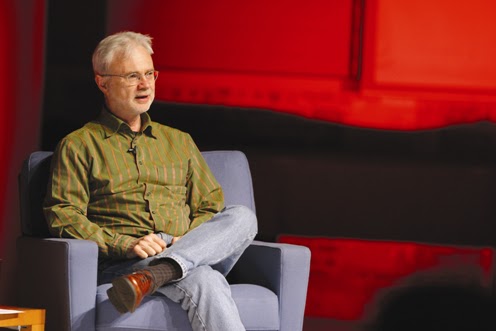
We owe much to Ralph Waldo Emerson, if for nothing else than his essay “Self-Reliance,” a fierce-minded challenge to the mediocrity and complacency that results when one aligns oneself with convention, imitation, conformity.
“To believe your own thought,” he says, “to believe that what is true for you in your private heart is true for all men — that is genius.”
More than 30 years after the premiere of John Adams’ Harmonielehre (which the Chicago Symphony Orchestra will perform Nov. 11-14), the work endures, fixed in the modern canon. “Genius” is a dangerous word to use in any context (save for quantum physics and Marx Brothers movies), but in Harmonielehre, as with many of history’s most influential works, we have a profoundly individual voice that articulates a universal vision. We are plunged into crisis at the onset, make peace with our wounds and move forward into transformation. We move from darkness to light, the same pilgrimage we make through Beethoven’s Fifth and Ninth symphonies, Strauss’ Death and Transfiguration, or Mahler’s Seventh Symphony.
Adams came to the crisis honestly. By his own account, the early 1980s found him “suffering from a perplexing and deeply disturbing creative block … a toxic state of mind that led to an 18-month dry spell and drove me to the blackest of moods.”
While speculation about the causes of melancholy is one of humanity’s primary occupations, in this instance, we fortunately do not need to speculate about the cause of at least some of Adams’ blackened mood. He was grappling with the influence of Arnold Schoenberg on music’s trajectory (Adams’ teacher Leon Kirchner had been a student of Schoenberg’s). He wrestled with the idea that, in Schoenberg’s work, something “twisted and contorted” had usurped the throne, and that the “audience for classical music during the 20th century was rapidly shrinking, in no small part because of the aural ugliness of so much of the new work being written.”
Famously, Adams had a dream that helped him break through the miasma, a dream in which a giant supertanker turned vertical and launched itself skyward from San Francisco Bay. Out of that vision emerged the pounding E minor chords that begin the piece. We hear both urgency and stasis, a tension between the need to move forward and its impossibility. Adams is resolving two issues: how he must move forward by composing, and how music might move forward from its stagnancy as well. The expression of a deeply felt personal crisis is magnified into an experience that others acknowledge and share. Once again, Emerson has been there before us: “In every work of genius, we recognize our own rejected thoughts.”
Considering the sway that atonal music held at the time (cf. Milton Babbitt’s article “Who Cares If You Listen?”), rejection of Schoenberg was “siding with the Philistines,” but Adams launched himself into the work head-on. The title is taken from a study of harmony published by Schoenberg in 1911, right before he abandoned tonality altogether. Here, Adams recaptures and reframes the title, and makes his case through the resultant work.
Harmonielehre doesn’t “solve” the problem, as if there were a solution to suffering, grasping, dissatisfaction and loss, but it articulates that there is a problem. It enables the listener to make an accord with his or her inner self that there is a struggle we’ve been thrust into, we did not choose to enter this world and that we must find a way out of it ourselves.
The first movement, in short, poses the problem, sets us within the landscape. Here we are, without a map and compass, disoriented and lost, yet with hope: there is harmony, we are moving forward. In that sense, he is overwhelmingly more optimistic than Schoenberg, whose philosophical vision leaves the listener in a world of complete isolation. Schoenberg places us in a state of total alienation. The absence of a home key creates a soundscape in which we cannot move forward, in which we are estranged from the very concept of “forward.” There is order in the sense that there are boundaries, but the world in which we inhabit is oppressive, fatalistic, claustrophobic. Adams starts us from a bleak position, but one in which traditional harmonic expression represents for us a ray of hope. We are in the rather grim key of E minor, but we ARE in a key.
From the crisis of the first movement, we move to awareness in the second, an awareness of impotence and depression, of our intrinsically wounded nature, of mourning (as we mourn the wounding of tonal music by Schoenberg?). This before the exaltation of the final movement, inspired by another dream (in this case of Adams’ infant daughter riding on the shoulders of Meister Eckhardt, a German mystic of the Middle Ages. The final movement brings us from the desert to the oasis. It is Adams’ answer to the questions posed at the onset: is it possible to escape from Schoenbergian desolation, is there a hopeful answer to the struggle we internally endure, is there the possibility of healing our wounds? The answer is a resounding yes. The movement is resolutely optimistic, celebrating the promise of harmony, both musical and personal, a destiny that waits for us should we choose to listen. We’ve been reassured.
Adams described the work as “a statement of belief in the power of tonality at a time when I was uncertain about its future.” It might also describe Adams’ state of mind at the time, a statement of belief in himself when he may have been uncertain about his own future and a counter-argument to Schoenberg’s insistence that there is no “home” to be had. It is heeding Eckhardt’s beautiful injunction to “Do exactly what you would do if you felt most secure.”
Peter Lefevre, based in California, writes about classical music for the Orange County Register and Opera News.
